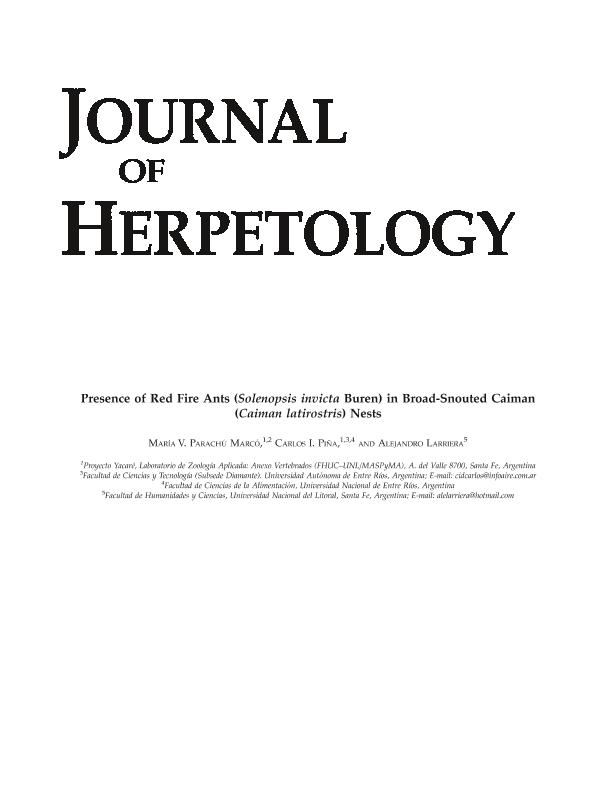Mostrar el registro sencillo del ítem
dc.contributor.author
Parachu Marco, Maria Virginia

dc.contributor.author
Piña, Carlos Ignacio

dc.contributor.author
Larriera, Alejandro

dc.date.available
2018-09-19T19:55:47Z
dc.date.issued
2012-06
dc.identifier.citation
Parachu Marco, Maria Virginia; Piña, Carlos Ignacio; Larriera, Alejandro; Presence of red fire ants (Solenopsis invicta Buren) in broad-snouted Caiman (Caiman latirostris) nests; Society for the Study of Amphibians and Reptiles; Journal of Herpetology; 46; 2; 6-2012; 228-232
dc.identifier.issn
0022-1511
dc.identifier.uri
http://hdl.handle.net/11336/60347
dc.description.abstract
The presence of Solenopsis invicta in Caiman latirostris nests is suspected to be a possible cause of death in caiman hatchlings, but this has not been documented within the native distribution of this ant. In crocodilian ranching programs, wild eggs are collected from the field, and delays between collection and transportation to incubators are usually minimized in the hope of maximizing embryo survival. We analyzed nests harvested during five consecutive nesting seasons of C. latirostris to determine the phenology of S. invicta colonization of caiman nests. The percentages of colonized caiman nests for each season were calculated. Densities of S. invicta mounds built on bare ground were assessed to determine potential relationships between density and the proportion of caiman nests colonized by the end of nesting season. We also evaluated whether S. invicta preferred certain habitats to establish their mounds. We found no relationship between S. invicta mound densities and the percentage of C. latirostris nests with Red Fire Ants. The presence of S. invicta mounds among years was similar between different habitats at the beginning of each season. We found that S. invicta can colonize C. latirostris nests during the breeding period and that colonization of nests is higher than 50 in seasons where rainfall was 200 mm at the beginning of the season (December and January). In contrast, during years in which rainfall was below 200 mm, caiman nest colonization was reduced. Copyright © 2012 Society for the Study of Amphibians and Reptiles.
dc.format
application/pdf
dc.language.iso
eng
dc.publisher
Society for the Study of Amphibians and Reptiles

dc.rights
info:eu-repo/semantics/openAccess
dc.rights.uri
https://creativecommons.org/licenses/by-nc-sa/2.5/ar/
dc.subject
Ant Colonization
dc.subject
Formicidae
dc.subject
Caiman Reproduction
dc.subject
Alligatoridae
dc.subject
Nesting Habitats
dc.subject.classification
Otras Ciencias Biológicas

dc.subject.classification
Ciencias Biológicas

dc.subject.classification
CIENCIAS NATURALES Y EXACTAS

dc.title
Presence of red fire ants (Solenopsis invicta Buren) in broad-snouted Caiman (Caiman latirostris) nests
dc.type
info:eu-repo/semantics/article
dc.type
info:ar-repo/semantics/artículo
dc.type
info:eu-repo/semantics/publishedVersion
dc.date.updated
2018-09-18T16:23:23Z
dc.journal.volume
46
dc.journal.number
2
dc.journal.pagination
228-232
dc.journal.pais
Estados Unidos

dc.journal.ciudad
Salt Lake City
dc.description.fil
Fil: Parachu Marco, Maria Virginia. Consejo Nacional de Investigaciones Científicas y Técnicas; Argentina. Universidad Nacional del Litoral. Facultad de Humanidades y Ciencias. Departamento de Ciencias Naturales. Laboratorio de Zoología Aplicada: Anexo Vertebrados (FHUC-UNL/MASPyMA); Argentina. Proyecto Yacaré; Argentina
dc.description.fil
Fil: Piña, Carlos Ignacio. Consejo Nacional de Investigaciones Científicas y Técnicas; Argentina. Universidad Nacional del Litoral. Facultad de Humanidades y Ciencias. Departamento de Ciencias Naturales. Laboratorio de Zoología Aplicada: Anexo Vertebrados (FHUC-UNL/MASPyMA); Argentina. Proyecto Yacaré; Argentina. Universidad Autónoma de Entre Ríos; Argentina
dc.description.fil
Fil: Larriera, Alejandro. Universidad Nacional del Litoral. Facultad de Humanidades y Ciencias; Argentina
dc.journal.title
Journal of Herpetology

dc.relation.alternativeid
info:eu-repo/semantics/altIdentifier/doi/https://dx.doi.org/10.1670/10-310
dc.relation.alternativeid
info:eu-repo/semantics/altIdentifier/url/http://www.bioone.org/doi/abs/10.1670/10-310
Archivos asociados
